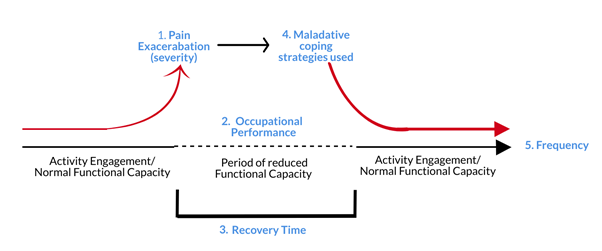Overactivity in Persistent Pain
While clinicians advise and encourage individuals with chronic or persistent pain to stay active, it is recognised that people can severely aggravate their pain by doing “too much”. When activity engagement results in a severe pain aggravation and a period of incapacity (where a person is unable to function because the intensity of their pain) this is referred to as overactivity.
People can aggravate their pain by either doing too much physical activity (i.e. going to the gym) or even spending too long on a sedentary task that requires a sustained spinal position (i.e. working at a desk). The increase in pain experienced is not caused by damage to tissues in the periphery, but rather the reaction of a sensitised nervous system.
About the OPPA
Current assessment concepts mainly rely on frequency to quantify the severity of overactivity behaviour in the context of persistent pain. The OPPA was developed to provide a more comprehensive assessment of overactivity severity. Our research team first deconstructed the overactivity concept using original descriptions and definitions found in the pain literature, established theoretical frameworks and qualitative research data. Five quantifiable severity features were identified as illustrated below. The OPPA provides a score for each of these severity features, as well as a total severity score.
Graphical Representation of Overactivity Severity Features Measured by the OPPA

How to use the OPPA
The OPPA was designed as a self-report measure that can be given directly to people with persistent pain without additional explanation or instructions. The questions obtained in the OPPA can also be used during interview based clinical assessments to gain a better understanding of the severity of overactivity behaviour in clinical pain populations.
The Overactivity in Persistent Pain Assessment (OPPA) is available in downloadable format:
Summary of Psychometric Properties of the OPPA
Validity | |
Structural Validity | A principal component analysis has confirmed that the five OPPA items are best represented by a single construct (i.e. overactivity severity) |
Construct Validity | Higher OPPA score are significantly and moderately correlated with more severe pain, higher levels of pain interference, poorer psychological functioning, and lower levels of activity participation. These predictable associations are supported by both theory and qualitative data. |
Reliability | |
Internal Consistency | Acceptable levels of internal consistency demonstrated (α = .78) |
Test-retest Reliability | Good levels of test-restest reliability demonstrated (ICC=.83) with low levels of measurement error |
| Responsiveness | Detects clinically meaningful changes in overactivity behaviour following treatment in line with changes observed through objective monitoring |
Links to Publications
Andrews, N.E., Chien, C.-W., Ireland, D., and Varnfield, M. (2020).Overactivity assessment in chronic pain: The development and psychometric evaluation of a multifaceted self-report assessment. European Journal of Pain , 25 (1) ejp.1664, 225-242. doi: 10.1002/ejp.1664
Andrews, N. E., Ireland, D., Deen, M., and Varnfield, M. (2023). Clinical utility of a mHealth assisted intervention for activity modulation in chronic pain: The pilot implementation of Pain ROADMAP. European Journal of Pain. https://doi.org/10.1002/ejp.2104
Contact Us
Please be in touch via email recover@uq.edu.au if you have any questions or would like to provide feedback on the assessment tool.
